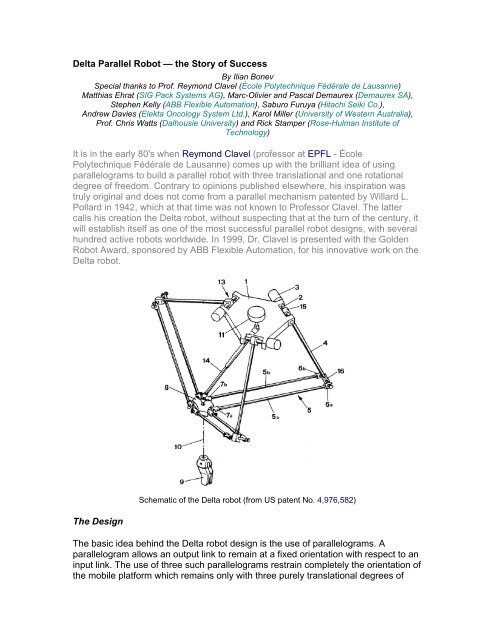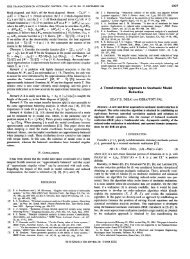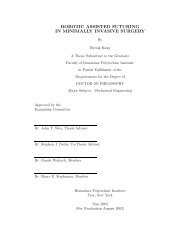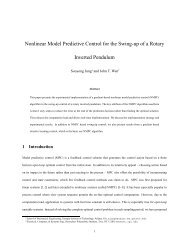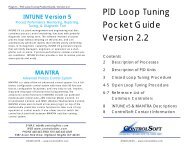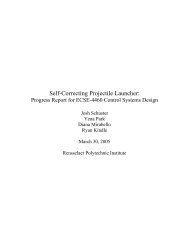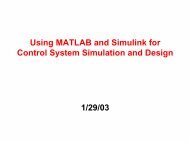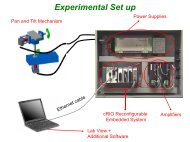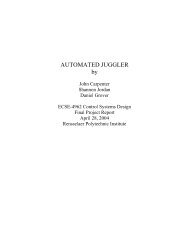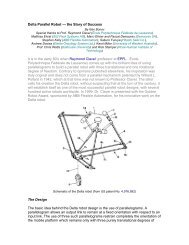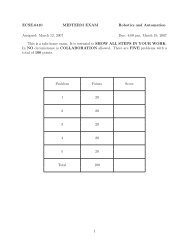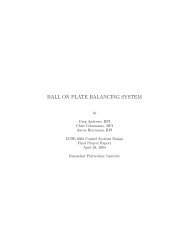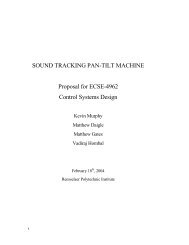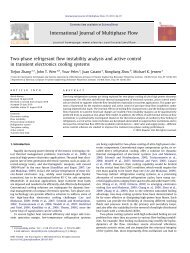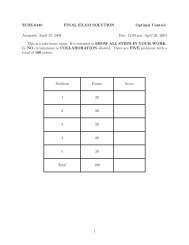Delta Parallel Robot — the Story of Success It is in ... - Robotics Group
Delta Parallel Robot — the Story of Success It is in ... - Robotics Group
Delta Parallel Robot — the Story of Success It is in ... - Robotics Group
You also want an ePaper? Increase the reach of your titles
YUMPU automatically turns print PDFs into web optimized ePapers that Google loves.
<strong>Delta</strong> <strong>Parallel</strong> <strong>Robot</strong> <strong>—</strong> <strong>the</strong> <strong>Story</strong> <strong>of</strong> <strong>Success</strong><br />
By Ilian Bonev<br />
Special thanks to Pr<strong>of</strong>. Reymond Clavel (École Polytechnique Fédérale de Lausanne)<br />
Matthias Ehrat (SIG Pack Systems AG), Marc-Olivier and Pascal Demaurex (Demaurex SA),<br />
Stephen Kelly (ABB Flexible Automation), Saburo Furuya (Hitachi Seiki Co.),<br />
Andrew Davies (Elekta Oncology System Ltd.), Karol Miller (University <strong>of</strong> Western Australia),<br />
Pr<strong>of</strong>. Chr<strong>is</strong> Watts (Dalhousie University) and Rick Stamper (Rose-Hulman Institute <strong>of</strong><br />
Technology)<br />
<strong>It</strong> <strong>is</strong> <strong>in</strong> <strong>the</strong> early 80's when Reymond Clavel (pr<strong>of</strong>essor at EPFL - École<br />
Polytechnique Fédérale de Lausanne) comes up with <strong>the</strong> brilliant idea <strong>of</strong> us<strong>in</strong>g<br />
parallelograms to build a parallel robot with three translational and one rotational<br />
degree <strong>of</strong> freedom. Contrary to op<strong>in</strong>ions publ<strong>is</strong>hed elsewhere, h<strong>is</strong> <strong>in</strong>spiration was<br />
truly orig<strong>in</strong>al and does not come from a parallel mechan<strong>is</strong>m patented by Willard L.<br />
Pollard <strong>in</strong> 1942, which at that time was not known to Pr<strong>of</strong>essor Clavel. The latter<br />
calls h<strong>is</strong> creation <strong>the</strong> <strong>Delta</strong> robot, without suspect<strong>in</strong>g that at <strong>the</strong> turn <strong>of</strong> <strong>the</strong> century, it<br />
will establ<strong>is</strong>h itself as one <strong>of</strong> <strong>the</strong> most successful parallel robot designs, with several<br />
hundred active robots worldwide. In 1999, Dr. Clavel <strong>is</strong> presented with <strong>the</strong> Golden<br />
<strong>Robot</strong> Award, sponsored by ABB Flexible Automation, for h<strong>is</strong> <strong>in</strong>novative work on <strong>the</strong><br />
<strong>Delta</strong> robot.<br />
The Design<br />
Schematic <strong>of</strong> <strong>the</strong> <strong>Delta</strong> robot (from US patent No. 4,976,582)<br />
The basic idea beh<strong>in</strong>d <strong>the</strong> <strong>Delta</strong> robot design <strong>is</strong> <strong>the</strong> use <strong>of</strong> parallelograms. A<br />
parallelogram allows an output l<strong>in</strong>k to rema<strong>in</strong> at a fixed orientation with respect to an<br />
<strong>in</strong>put l<strong>in</strong>k. The use <strong>of</strong> three such parallelograms restra<strong>in</strong> completely <strong>the</strong> orientation <strong>of</strong><br />
<strong>the</strong> mobile platform which rema<strong>in</strong>s only with three purely translational degrees <strong>of</strong>
freedom. The <strong>in</strong>put l<strong>in</strong>ks <strong>of</strong> <strong>the</strong> three parallelograms are mounted on rotat<strong>in</strong>g levers<br />
via revolute jo<strong>in</strong>ts. The revolute jo<strong>in</strong>ts <strong>of</strong> <strong>the</strong> rotat<strong>in</strong>g levers are actuated <strong>in</strong> two<br />
different ways: with rotational (DC or AC servo) motors or with l<strong>in</strong>ear actuators.<br />
F<strong>in</strong>ally, a fourth leg <strong>is</strong> used to transmit rotary motion from <strong>the</strong> base to an end-effector<br />
mounted on <strong>the</strong> mobile platform.<br />
The use <strong>of</strong> base-mounted actuators and low-mass l<strong>in</strong>ks allows <strong>the</strong> mobile platform to<br />
achieve accelerations <strong>of</strong> up to 50 G <strong>in</strong> experimental environments and 12 G <strong>in</strong><br />
<strong>in</strong>dustrial applications. Th<strong>is</strong> makes <strong>the</strong> <strong>Delta</strong> robot a perfect candidate for pick and<br />
place operations <strong>of</strong> light objects (from 10 gr to 1 kg). Ideally, its workspace <strong>is</strong> <strong>the</strong><br />
<strong>in</strong>tersection <strong>of</strong> three right circular tori. The <strong>Delta</strong> robots available on <strong>the</strong> market<br />
operate typically <strong>in</strong> a cyl<strong>in</strong>drical workspace which <strong>is</strong> 1 m <strong>in</strong> diameter and 0.2 m high.<br />
The Patent<br />
As simple as it <strong>is</strong>, <strong>the</strong> design <strong>of</strong> <strong>the</strong> <strong>Delta</strong> robot <strong>is</strong> covered by a family <strong>of</strong> 36 patents<br />
<strong>of</strong> which <strong>the</strong> most important are <strong>the</strong> WIPO patent <strong>is</strong>sued on June 18, 1987 (WO<br />
87/03528), <strong>the</strong> US patent <strong>is</strong>sued on December 11, 1990 (US 4,976,582), and <strong>the</strong><br />
European patent <strong>is</strong>sued on July 17, 1991 (EP 0 250 470). Overall, <strong>the</strong>se patents<br />
protect <strong>the</strong> <strong>in</strong>vention <strong>in</strong> USA, Canada, Japan, and most West European countries.<br />
The patents do not specify <strong>the</strong> way <strong>in</strong> which <strong>the</strong> <strong>Delta</strong> structure <strong>is</strong> actuated <strong>in</strong> order<br />
to <strong>in</strong>corporate <strong>the</strong> basic design as well as its variants (such as <strong>the</strong> Triaglide or <strong>the</strong><br />
L<strong>in</strong>apod).<br />
The <strong>Delta</strong> <strong>Robot</strong> on <strong>the</strong> Market<br />
The h<strong>is</strong>tory <strong>of</strong> <strong>the</strong> <strong>Delta</strong> robot market<strong>in</strong>g <strong>is</strong> long, complicated, and <strong>in</strong>trigu<strong>in</strong>g. <strong>It</strong> all<br />
started <strong>in</strong> 1983 when <strong>the</strong> two Sw<strong>is</strong>s bro<strong>the</strong>rs Marc-Olivier and Pascal Demaurex<br />
created <strong>the</strong> company Demaurex based <strong>in</strong> Romanel-sur-Lausanne, Switzerland. After<br />
purchas<strong>in</strong>g a license for <strong>the</strong> <strong>Delta</strong> robot <strong>in</strong> 1987, <strong>the</strong>ir major objective became to<br />
commercialize <strong>the</strong> robot for <strong>the</strong> packag<strong>in</strong>g <strong>in</strong>dustry. After several years, Demaurex<br />
succeeded <strong>in</strong> occupy<strong>in</strong>g a major place <strong>in</strong> th<strong>is</strong> new difficult market. The company<br />
product went through a number <strong>of</strong> modifications. Four application versions were<br />
commercialized under <strong>the</strong> names <strong>of</strong> Pack-Placer, L<strong>in</strong>e-Placer, Top-Placer, and<br />
Presto. Demaurex now claims to have sold some 500 <strong>Delta</strong> robots worldwide.
Demaurex's L<strong>in</strong>e-Placer <strong>in</strong>stallation for <strong>the</strong> packag<strong>in</strong>g <strong>of</strong> pretzels<br />
<strong>in</strong> an <strong>in</strong>dustrial bakery (courtesy <strong>of</strong> Demaurex)<br />
The patent on <strong>the</strong> <strong>Delta</strong> robot was bought by <strong>the</strong> bro<strong>the</strong>rs Demaurex from EPFL <strong>in</strong><br />
1996. However, before <strong>the</strong> transaction took place, EPFL had already sold two<br />
licenses. The first one concern<strong>in</strong>g <strong>the</strong> robots <strong>of</strong> small dimension (arm +<br />
parallelogram < 800 mm) was attributed exclusively to Demaurex <strong>in</strong> 1987. The<br />
second one, concern<strong>in</strong>g robots <strong>of</strong> larger dimensions, was sold to AID and later<br />
resold to DeeMed. Th<strong>is</strong> company, bought later by <strong>the</strong> Swed<strong>is</strong>h Elekta, specializes <strong>in</strong><br />
<strong>the</strong> surgical doma<strong>in</strong> and manufactures a <strong>Delta</strong> robot used to carry a heavy (20 kg)<br />
microscope (SurgiScope). The <strong>Delta</strong> robot technology was consequently sold to<br />
Medtronic at <strong>the</strong> end <strong>of</strong> 1999.
SurgiScope <strong>in</strong> action at <strong>the</strong> Surgical <strong>Robot</strong>ics Lab, Humboldt-University at Berl<strong>in</strong><br />
(courtesy <strong>of</strong> Pr<strong>of</strong>. Dr. Tim C. Lueth)<br />
Before <strong>the</strong> SurgiScope transaction, Elekta IGS entered negotiations over its <strong>Delta</strong><br />
license with <strong>the</strong> Zurich based Global technology group ABB. As a result, ABB<br />
acquired a license to manufacture <strong>Delta</strong> robots <strong>of</strong> larger dimensions. In <strong>the</strong><br />
meantime, Demaurex announced its dec<strong>is</strong>ion to produce robots <strong>of</strong> greater<br />
dimensions (almost 1,200 mm). However, Demaurex may not produce robots <strong>of</strong><br />
dimensions greater than that, s<strong>in</strong>ce <strong>the</strong> company undertook <strong>the</strong> obligation not to<br />
enter <strong>the</strong> over 1,200 mm market, when it purchased <strong>the</strong> exclusive under 800 mm<br />
license.<br />
<strong>It</strong> seems probable that Demaurex negotiated with <strong>the</strong> German GROB-Werke over<br />
<strong>the</strong> license to produce <strong>the</strong> TRIAGLIDE 5g, as well as with Mikron Technology <strong>Group</strong><br />
for <strong>the</strong>ir Triaglide, both <strong>of</strong> which are <strong>Delta</strong> robots with l<strong>in</strong>ear motors. <strong>It</strong> <strong>is</strong> <strong>in</strong>terest<strong>in</strong>g,<br />
though, that <strong>the</strong> Krause & Mauser <strong>Group</strong> has a patent for <strong>the</strong>ir Quickstep 3-ax<strong>is</strong><br />
mill<strong>in</strong>g mach<strong>in</strong>e (US 6,161,992) which <strong>is</strong> aga<strong>in</strong> a <strong>Delta</strong> robot with l<strong>in</strong>ear drives. In<br />
addition, Renault Automation Comau <strong>in</strong>troduced at EMO'99 <strong>in</strong> Par<strong>is</strong> <strong>the</strong>ir Urane SX<br />
mill<strong>in</strong>g mach<strong>in</strong>e which <strong>is</strong> remarkably similar to <strong>the</strong> Quickstep design.
Hitachi Seiki's <strong>Delta</strong> robots for pick-and-place and drill<strong>in</strong>g<br />
(courtesy <strong>of</strong> Hitachi Seiki)<br />
Demaurex also licensed <strong>the</strong> Japanese company Hitachi Seiki to manufacture <strong>Delta</strong><br />
robots <strong>of</strong> small dimensions for packag<strong>in</strong>g (DELTA) and for drill<strong>in</strong>g (PA35). In fact,<br />
Hitachi Seiki represents Demaurex <strong>in</strong> Japan.
ABB Flexible Automation's IRB 340 FlexPicker (courtesy <strong>of</strong> ABB Flexible Automation)<br />
ABB Flexible Automation launched its <strong>Delta</strong> robot <strong>in</strong> 1999 under <strong>the</strong> name IRB 340<br />
FlexPicker. Three <strong>in</strong>dustry sectors were aimed <strong>—</strong> <strong>the</strong> food, pharmaceutical, and<br />
electronics <strong>in</strong>dustries. The FlexPicker <strong>is</strong> equipped with an <strong>in</strong>tegrated vacuum system<br />
capable <strong>of</strong> rapid pick and release <strong>of</strong> objects weigh<strong>in</strong>g up to 1 kg. The robot <strong>is</strong> guided<br />
with a mach<strong>in</strong>e v<strong>is</strong>ion system by Cognex and an ABB S4C controller. Optionally, <strong>the</strong><br />
robot may be equipped with a motion controller and v<strong>is</strong>ion system by Adept<br />
Technology. The atta<strong>in</strong>able velocities are 10 m/sec and 3.6 deg/sec (about 150 picks<br />
per m<strong>in</strong>ute), and <strong>the</strong> accelerations are up to 100 m/sec² and 1.2 rad/sec². The robot<br />
comes <strong>in</strong> two versions, one <strong>of</strong> which <strong>is</strong> sealed, corrosion-res<strong>is</strong>tant wash-down<br />
version, designed especially for clean-<strong>in</strong>tensive environments.<br />
After more than fifteen years as <strong>the</strong> sole player on <strong>the</strong> market, Demaurex suddenly<br />
faced <strong>the</strong> dec<strong>is</strong>ion <strong>of</strong> <strong>the</strong> Swed<strong>is</strong>h giant ABB to enter th<strong>is</strong> lucrative market. In an<br />
attempt to ensure its long-term stability, Demaurex changed its l<strong>in</strong>e <strong>of</strong> production<br />
from naked <strong>Delta</strong> robots to complete robot cells. However, <strong>in</strong> order to ga<strong>in</strong> a world<br />
market, <strong>the</strong> small Demaurex started look<strong>in</strong>g for a partner. And it <strong>is</strong> thus, that<br />
Demaurex became acquired by <strong>the</strong> Sw<strong>is</strong>s <strong>Group</strong> SIG at <strong>the</strong> end <strong>of</strong> 1999.<br />
The SIG <strong>Group</strong> cons<strong>is</strong>ts <strong>of</strong> three branches, <strong>of</strong> which <strong>the</strong> SIG Pack branch, only,<br />
employs some 2,000 workers <strong>—</strong> a company big enough to <strong>of</strong>fer Demaurex <strong>the</strong> so<br />
much needed access to <strong>the</strong> world market. Demaurex will keep its name and even its
two founders and CEOs. Presently, three different <strong>Delta</strong> robot models are <strong>of</strong>fered by<br />
SIG Pack Systems, whereas <strong>the</strong> C23 and C33 are manufactured by Demaurex while<br />
<strong>the</strong> CE33 <strong>is</strong> fabricated by SIG Pack Systems.<br />
Two <strong>of</strong> <strong>the</strong> three <strong>Delta</strong> robot models <strong>of</strong>fered by SIG Pack Systems, C33 and CE33<br />
(courtesy <strong>of</strong> SIG Pack Systems)<br />
The <strong>Delta</strong> <strong>Robot</strong> In Academia<br />
The <strong>Delta</strong> robot design has attracted great <strong>in</strong>terest not only <strong>in</strong> <strong>in</strong>dustry but also <strong>in</strong><br />
university labs. A number <strong>of</strong> variants have been proposed <strong>in</strong> <strong>the</strong> literature but most<br />
<strong>of</strong> those that have been prototyped stay close to <strong>the</strong> orig<strong>in</strong>al design. One such<br />
modified <strong>Delta</strong> robot was built at <strong>the</strong> University <strong>of</strong> Maryland. Ano<strong>the</strong>r, modified<br />
version was constructed at <strong>the</strong> University <strong>of</strong> Genoa. In that design, <strong>the</strong><br />
parallelograms are replaced by equivalent mechan<strong>is</strong>ms. Yet ano<strong>the</strong>r highlyoptimized<br />
version, NUWAR, was built <strong>in</strong> <strong>the</strong> University <strong>of</strong> Western Australia. The<br />
NUWAR <strong>is</strong> claimed to reach accelerations <strong>of</strong> up to 600 m/sec² and differs from <strong>the</strong><br />
o<strong>the</strong>r <strong>Delta</strong> robot versions <strong>in</strong> its non-coplanar arrangement <strong>of</strong> <strong>the</strong> axes <strong>of</strong> its rotary<br />
actuators. Three l<strong>in</strong>ear-motor versions were also constructed at Ferd<strong>in</strong>and-von-<br />
Ste<strong>in</strong>be<strong>is</strong> Schule, ETH Zurich, and <strong>the</strong> University <strong>of</strong> Stuttgart. Ano<strong>the</strong>r l<strong>in</strong>ear version<br />
and two conventional <strong>Delta</strong> robots were fabricated <strong>in</strong> <strong>the</strong> scope <strong>of</strong> student projects at<br />
<strong>the</strong> University <strong>of</strong> Michigan (1, 2, 3, 4). A classical <strong>Delta</strong> robot was also modeled at<br />
LIRM. A more different application <strong>of</strong> a slightly modified <strong>Delta</strong> robot, as part <strong>of</strong> a<br />
decoupled 6-DOF haptic <strong>in</strong>terface, was implemented at Tohoku University. And an<br />
even more orig<strong>in</strong>al application <strong>of</strong> <strong>the</strong> <strong>Delta</strong> robot, as a vegetable transplant<strong>in</strong>g<br />
device, was implemented at Dalhousie University.<br />
Naturally, <strong>the</strong> greatest concentration <strong>of</strong> <strong>Delta</strong> robot family members <strong>is</strong> found at its<br />
birthplace <strong>—</strong> l'École Polytechnique Fédérale de Lausanne (EPFL). There <strong>is</strong> a haptic<br />
device built by EPFL's Virtual Reality and Active Interfaces <strong>Group</strong>. Their <strong>Delta</strong> Force<br />
Feedback Device <strong>is</strong> commercially available for about 20,000 USD. Ano<strong>the</strong>r typical
<strong>Delta</strong> robot was also constructed at <strong>the</strong> EPFL's Automation Institute. And <strong>of</strong> course,<br />
several <strong>Delta</strong> robots (<strong>Delta</strong> 720, L<strong>in</strong>ear <strong>Delta</strong>, and Micro<strong>Delta</strong> 240) were built by <strong>the</strong><br />
<strong>Parallel</strong> <strong>Robot</strong>ics <strong>Group</strong> headed by Pr<strong>of</strong>. Reymond Clavel. Aston<strong>is</strong>h<strong>in</strong>gly, one <strong>of</strong> <strong>the</strong><br />
latest <strong>in</strong>ventions <strong>of</strong> that <strong>Group</strong> makes use <strong>of</strong> <strong>the</strong> same parallelogram concept <strong>in</strong><br />
order to construct a robot with only orientational degrees <strong>of</strong> freedom (Argos).<br />
. . .<br />
The <strong>Delta</strong> robot rema<strong>in</strong>s without competitors <strong>in</strong> <strong>the</strong> sector <strong>of</strong> rapid transfer robots.<br />
Chances are that next time you savour delicious chocolate candies, <strong>the</strong>y would have<br />
been placed <strong>in</strong> that fancy box by <strong>the</strong> rapid hand <strong>of</strong> a <strong>Delta</strong> robot.<br />
Bibliography<br />
Clavel, R., "Conception d'un robot parallèle rapide à 4 degrés de liberté," Ph.D. Thes<strong>is</strong>, EPFL,<br />
Lausanne, Switzerland, 1991.<br />
Clavel, R., "Device for <strong>the</strong> Movement and Position<strong>in</strong>g <strong>of</strong> an Element <strong>in</strong> Space," US Patent No.<br />
4,976,582, December 11, 1990.<br />
Merlet, J.-P., <strong>Parallel</strong> <strong>Robot</strong>s, Kluwer Academic Publ<strong>is</strong>hers, 2000.<br />
Miller, K., "Model<strong>in</strong>g <strong>of</strong> Dynamics and Model-Based Control <strong>of</strong> DELTA Direct-Drive <strong>Parallel</strong><br />
<strong>Robot</strong>," Journal <strong>of</strong> <strong>Robot</strong>ics and Mechatronics, Vol. 17, No. 4, pp. 344-352, 1995.<br />
Miller, K., "The Proposal <strong>of</strong> a New Model <strong>of</strong> Direct Drive <strong>Robot</strong> DELTA-4 Dynamics," Int. Conf.<br />
on Advanced <strong>Robot</strong>ics (ICAR'92), Tokyo, Japan, pp. 411-416, November 1-2, 1992.<br />
Miller, K., "Experimental Verification <strong>of</strong> Model<strong>in</strong>g <strong>of</strong> <strong>Delta</strong> <strong>Robot</strong> Dynamics by Direct Application<br />
<strong>of</strong> Hamilton's Pr<strong>in</strong>ciple," IEEE Int. Conf. on <strong>Robot</strong>ics and Automation (ICRA'95), Nagoya,<br />
Japan, pp. 532-537, May 25-27, 1995.<br />
Miller, K., "On Accuracy and Computational Efficiency <strong>of</strong> DELTA Direct Drive <strong>Robot</strong> Dynamics<br />
Model," Int. Symp. on Microsystems, Intelligent Materials and <strong>Robot</strong>s, Sendai, Japan, pp. 568-<br />
571, September 27-29, 1995.<br />
Miller, K., "Model-Based Control <strong>of</strong> DELTA Direct Drive <strong>Parallel</strong> <strong>Robot</strong>; Trajectory Track<strong>in</strong>g<br />
Experiments," 26th Int. Symp. <strong>of</strong> Industrial <strong>Robot</strong>s (ISIR'95), S<strong>in</strong>gapore, pp. 491-496, October<br />
4-6, 1995.<br />
Miller, K., and Clavel, R., "The Lagrange-Based Model <strong>of</strong> <strong>Delta</strong>-4 <strong>Robot</strong> Dynamics,"<br />
<strong>Robot</strong>ersysteme, Spr<strong>in</strong>ger-Verlag, Vol. 8, No. 4, pp. 49-54, 1992.<br />
Miller, K., "Mechanics <strong>of</strong> New UWA <strong>Robot</strong>," 13th RoManSy, Zakopane, Poland, July 3-6, 2000.<br />
Pollard, W. L., "Position Controll<strong>in</strong>g Apparatus," US Patent No. 2,286,571, June 16, 1942.<br />
"Demaurex change de ma<strong>in</strong>s ma<strong>is</strong> reste su<strong>is</strong>se," ROBAUT, J'automat<strong>is</strong>e, No. 8, January-<br />
February 2000.<br />
Fages, G., "La vérité sur les robots parallèles," ROBAUT, J'automat<strong>is</strong>e, No. 4, June-July 1999.<br />
Stamper, R. E., "A Three Degree <strong>of</strong> Freedom <strong>Parallel</strong> Manipulators with Only Translational<br />
Degrees <strong>of</strong> Freedom," Ph.D. Thes<strong>is</strong>, University <strong>of</strong> Maryland, MD, USA, 1997.<br />
<strong>Parallel</strong> K<strong>in</strong>ematic Mach<strong>in</strong>es: Theoretical Aspects and Industrial Requirements, C. R. Boër, L.<br />
Mol<strong>in</strong>ari-Tosatti, and K.S. Smith (Eds), Spr<strong>in</strong>ger-Verlag, 1999.<br />
Copyright © 2000–2001 by Ilian Bonev Last Update: May 6, 2001


